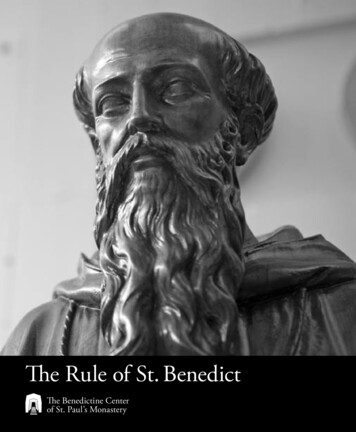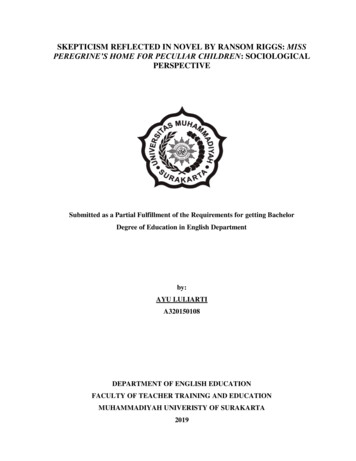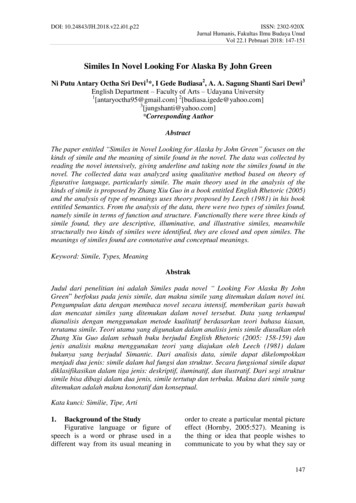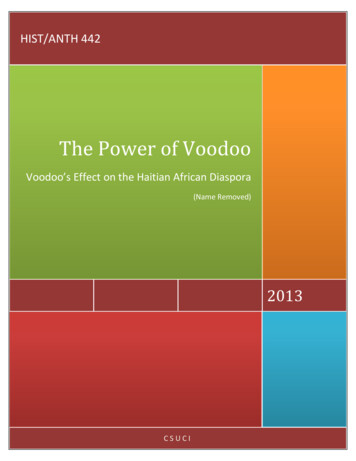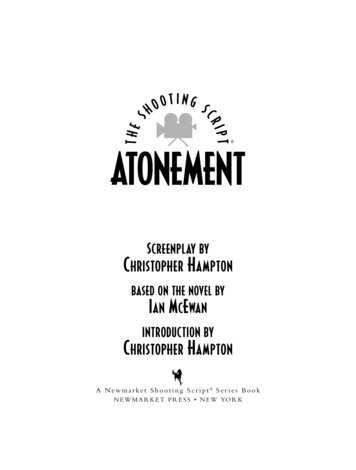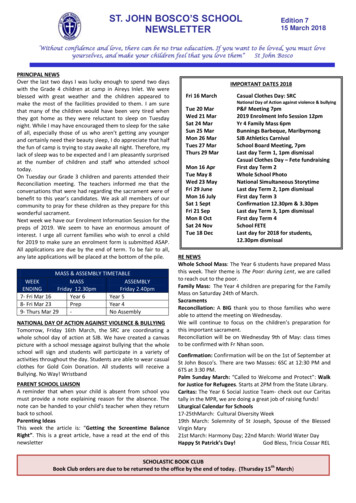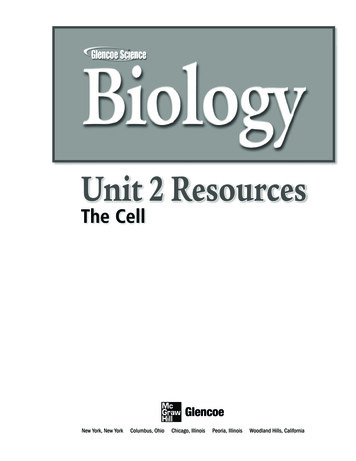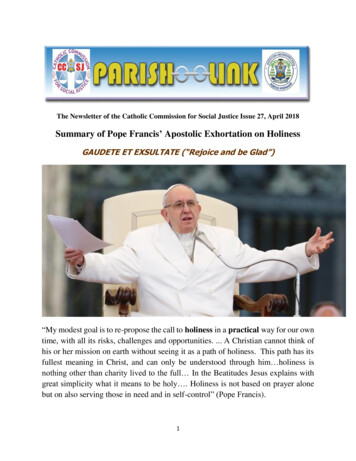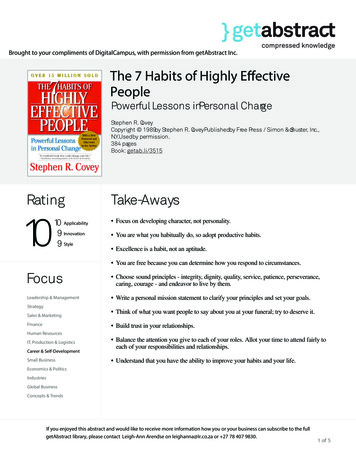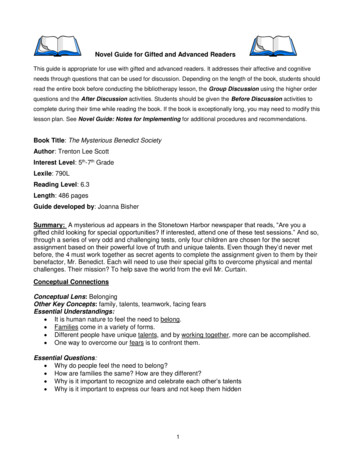
Transcription
Novel Guide for Gifted and Advanced ReadersThis guide is appropriate for use with gifted and advanced readers. It addresses their affective and cognitiveneeds through questions that can be used for discussion. Depending on the length of the book, students shouldread the entire book before conducting the bibliotherapy lesson, the Group Discussion using the higher orderquestions and the After Discussion activities. Students should be given the Before Discussion activities tocomplete during their time while reading the book. If the book is exceptionally long, you may need to modify thislesson plan. See Novel Guide: Notes for Implementing for additional procedures and recommendations.Book Title: The Mysterious Benedict SocietyAuthor: Trenton Lee ScottInterest Level: 5th-7th GradeLexile: 790LReading Level: 6.3Length: 486 pagesGuide developed by: Joanna BisherSummary: A mysterious ad appears in the Stonetown Harbor newspaper that reads, “Are you agifted child looking for special opportunities? If interested, attend one of these test sessions.” And so,through a series of very odd and challenging tests, only four children are chosen for the secretassignment based on their powerful love of truth and unique talents. Even though they’d never metbefore, the 4 must work together as secret agents to complete the assignment given to them by theirbenefactor, Mr. Benedict. Each will need to use their special gifts to overcome physical and mentalchallenges. Their mission? To help save the world from the evil Mr. Curtain.Conceptual ConnectionsConceptual Lens: BelongingOther Key Concepts: family, talents, teamwork, facing fearsEssential Understandings: It is human nature to feel the need to belong. Families come in a variety of forms. Different people have unique talents, and by working together, more can be accomplished. One way to overcome our fears is to confront them.Essential Questions: Why do people feel the need to belong? How are families the same? How are they different? Why is it important to recognize and celebrate each other’s talents Why is it important to express our fears and not keep them hidden1
Affective Focus (Bibliotherapy)Introductory Activity/Hook1. Go to the website http://www.mysteriousbenedictsociety.com/ and read the section titled,“Summary” of Book 1- The Mysterious Benedict Society. (see Appendix A)2. Next, watch the first 3min. 30sec. only of the 8min 30sec student-made You Tube trailer for,The Mysterious Benedict Society at http://www.youtube.com/watch?v PDQYbrQ-zBQ. Thisclip gives students enough background information to get them excited about the book, but nottoo much to give away the whole plot.3. Finally, have students go to the Games section of the websitehttp://www.mysteriousbenedictsociety.com/ and play, Which Mysterious Benedict SocietyMember are You? Discuss student’s results orally with the group.4. Read the short descriptions of each of the 4 main characters from Appendix B. Allow studentsto tell which character they identify with the most, giving specific examples from their life.Menu of Bibliotherapy QuestionsIdentification: How are Reynie, Sticky, Kate and Constance different from the other gifted children who tookMr. Benedict’s tests? (Reread passage on p. 102) What unique talent(s) does Reynie have? Sticky? Kate? Constance? How does Reynie’s “family” change from the beginning of the book to the end of the book?Sticky’s? Kate’s? Constance’s? What fears does each of the children have? What kind of person is Mr. Benedict?Catharsis: How did Reynie feel about living at the orphanage? How do you know it bothers Kate that her father (allegedly) abandoned her when she wassmall? (p. 51-54) Why does Reynie wonder if it’s worse to have felt loved and then be rejected, or to havealways felt alone? (p. 255) How did Sticky feel about his parents using his intelligence to make money? How did Sticky feel when he overheard his parents say that maybe it’s for the best that Stickyran away? (read 478-481 for explanation) How did Reynie feel when he overheard Mr. Benedict referring to him as, “Our young hero,”when talking to Number Two? (p. 142) How do you think the children were feeling when they met Mr. Curtain for the 1st time, and theythought it was Mr. Benedict? (p. 176) How do the children’s feelings about each other change in the story? Which character do you feel you’re most like? Why?Insight: What do your family and friends say and do to make you feel wanted? What does it feel like to not belong or feel wanted? How can you help others (family members, friends, classmates) feel like they belong? Have you ever felt betrayed? How did it make you feel? How do you feel when you use your talents to contribute to a team effort? When you think about your fears or worries, how does that make you feel?Universalization/Follow up ActivityWrite a letter to someone letting them know they are needed and loved by you. Let them know howyou feel about them and why you feel that way. Mention their specific talents and what makes themspecial. Ask about one of their fears (or worries), and let them know how you might help themovercome it. Sign and deliver your letter. If you feel comfortable, share the results with the groupand/or your teacher.2
Reading Comprehension: Independent Work and Group DiscussionTo foster strong reading comprehension, literacy skills, and love of literature, students need to readcritically, respond to what they read with text-based evidence, develop a robust vocabulary, andengage in high level discussion with peers. The following activities address these components.Before Group Discussion (Activities for students to complete independently)A. Knowledge and Comprehension Questions related to the novel. Students use sticky notes tolocate answers in the text as they read. Teacher may use student’s answers for a grade.Knowledge Questions Can you list and describe the 6 main characters? How were the 4 children chosen as Mr. Benedict’s special assignment? Why hadn’t Mr. Benedict been able to form a team before this? What is the relationship between Mr. Benedict and Mr. Curtain? Can you describe the L.I.V.E. School on the island of Nomansanisland? Mr. Curtain was sending out subliminal ideas over the airways; what did the messages say? What is the name of machine Mr. Curtain built to dispatch the messages?Comprehension Questions Why do Rhonda and Number Two follow Mr. Benedict around so closely? Why is Mr. Curtain in a wheelchair? What triggers Mr. Benedict’s narcolepsy? Mr. Curtain’s? What was Mr. Curtain trying to accomplish? Why is Constance the only one who can hear the messages without the aid of Mr. Benedict’smachine? Why do Kate and Constance have to crawl through the air shaft to get to Reynie and Sticky’sroom to talk? Why did the children work so hard to become the “top students?” Why does The Whisperer ask, “What is your greatest fear?” How does The Whisperer make the children feel good? Reread p. 378. Why does Mr. Curtain tell Martina and S.Q., “The only way fears disappear is ifyou confront them but who wants to do that?” What will happen after Mr. Curtain starts recording the messages to go over the airways? What do the children find in Memory Terminal? Can you explain how the children and Mr. Benedict solve eliminate The Whisperer? At the end of the story, why does Mr. Benedict want to just let the children play outside eventhough it’s getting dark?3
B. Vocabulary Study: Students will complete the following activities with vocabulary from the novel.The activities may be used for a grade, but should also be included in the discussion. Students look up the word in the dictionary or online, noting the definition that best fits how theword is used in the passage. Also, determine possible synonyms and evaluate the author’suse of the word in the passage. Students will complete a graphic organizer provided by the teacher.Vocabulary Words embroidered narcolepsy prodigious gumption profoundly anvils imprudent insolent de’ja vu empathy tactical austere interminable emetic flummox concur pernicious ignominious melee victualsp. 6p. 75p. 78p. 80p.97p. 208p. 228p. 237p. 238p. 256p. 259p. 317p. 353p. 400p. 420p. 479p. 480p. 483p. 484p. 485Group Discussion: Teacher-facilitated small group discussion. Teacher may choose to providestudents with a set of the questions prior to the discussion. Students should also be encouraged tocreate their own questions.Higher-Level Questions (using Bloom’s categories):1. Application Do you know of another instance where twins seem to be opposites? If you were an orphan, what do you think you would you miss? What examples from the story can you find to support the following statement? This lineis repeated throughout the book: “The only rule is, there are no rules (at L.I.V.E.).” Onthe contrary, there seems to be numerous rules to follow. If you met Mr. Curtain, what questions would you ask him? Predict what would have happened if Mr. Benedict hadn’t destroyed “The Whisperer.” What other ways can you think of to solve the problem?2. Analysis What genre is this story and how do you know? What factors distinguish the main characters from the secondary characters? What qualities did the 4 children have that allowed them to be chosen for Mr. Benedict’ssecret mission?4
Besides a powerful love of truth, what other commonality make the 4 children a goodchoice for Mr. Benedict’s secret mission? (Children w/o guardians are in a particular kind ofdanger – parents don’t want to send their children into danger p. 82)What clues did the author give to help you figure out that Constance was only 2? (Alwaystired, small, terrible manners, spilled food, didn’t know the ending for the phrase,“Good Lu .”)What are the major differences between the twins, Mr. Benedict and Mr. Curtain?How does The Whisperer work?What steps were needed to solve the problem of Mr. Curtain trying to take over the world?What part of the story was the most exciting? Funniest? Saddest?Compare and contrast Mr. Benedict’s study with Mr. Curtain’s office. What does eachreveal about their character? (p. 70-71 and 239)3. Evaluation Based on what you know, how would you explain the significances of the live violet in Mr.Benedict’s office and the artificial violet in Mr. Curtain’s office? (p.239) Reynie, Sticky, Kate and Constance put a plant product in their classmate’s food to makethem sick. This seems unethical. Can you justify this action? Why or why not? What does this story tell you about belonging? About family? About teamwork? Why would you recommend or not recommend this book?4. Synthesis How would this story have been different if Mr. Benedict hadn’t found Sticky’s parents andbrought them to take him home? Can you develop a new character for the story; a gifted child with special talents to add toMr. Benedict’s group of secret agents? Can you negotiate with Mr. Curtain to convince him to destroy his whisperer and become agood character? Can you propose an alternate way (other than Morse code) that Mr. Benedict, Mulligan,Number Two and Rhonda could have communicated with the children while they were onthe island of Nomansanisland? Can you think of 2-3 new titles that would convey what the story is about?After Group Discussion: Activities for students to complete with a partner, in a small group, orindividually. Activities may be used for a grade.A. Connections to the Curriculum: Students will make connections to a curriculum area (math,science, social studies, language arts, art, or careers) using one of the concepts from thestory. The product should reflect creativity as well as critical thinking. Math –Plan another “test” the gifted children need to pass to get chosen for Mr.Benedict’s secret society. The test needs to be clever by using logic, mystery, riddle,game, multiple meanings of words, deductive reasoning, etc. It should involve mathconcepts such as geometry, patterns, time (clock and calendar), money, graphs,tables, etc. Science/Social Studies – In the story, people received subliminal messages about animpending emergency. If people are prepared for an emergency, it can save lives andmake it easier to get through. Choose an emergency situation. (i.e. fire, crash, tornado,hurricane, earthquake, power outage, flood) Research information about the situation,as well as the steps people can take to prepare for such an event. Create a pamphletthat educates people about the emergency, and steps they can take to prepare for it.(For example, a tri-fold brochure in MSWord) Distribute your flyer to classmates, familyand friends.5
Language Arts-Writing –1. Take the test at the end of the book, “Are you Mysterious Benedict Societymaterial?” Check the answer key. From your answers and the character you are mostlike, figure out the pattern to the questions and answers. Write 5 new questions thatcould be part of the test.2. Metaphor activity- Trenton Lee Scott includes descriptive language metaphors in hisbook. For example, “Where adult thoughts would lumber into the mind like an elephant,children’s creep in on cat feet and find a shadowy place to hide.” (p. 101) and, “so thatthe (fall) trees appeared candy-coated.” Look through, The Mysterious BenedictSociety and find at least 3 other descriptive metaphors. Write 5 new metaphors todescribe different ideas from the book.Arts –1. Create a representation listing the Morse code. Create an activity with a Morse codemessage for your classmates to figure out. Develop 5 different methods to “send” theMorse code message (flashlight, electric keyboard, etc.)2. Watch the rest of the trailer: http://www.youtube.com/watch?v PDQYbrQ-zBQWrite your own screenplay for the book or your favorite scene in the book and act it outfor the class. Video tape your play. With your parent’s permission, put your video onYouTube for others interested in the Mysterious Benedict Society.Careers –The Special Opportunity for Gifted Children was listed as an advertisementin the newspaper. Research the following advertising techniques: Emotional response,Bandwagon, Repetition, Promotions, Association, Claims, Plain Folks Appeal,Glittering Generality, Facts & Figures, Hidden Fears, and Snob Appeal. Make a 3column table that lists at least 5 of these advertising technique, their description, and 1or more real-life examples of each technique. Using 1 of the techniques, create yourown advertisement (newspaper or magazine ad, billboard, on-line ad, info-graphic,flyer, TV or radio commercial, etc.) for a product, service, or opportunity.B. Creative Reading: Using the following list of creative products, students will complete a projectreflecting their personal connection with the novel (students may determine their own creative productwith the approval of the teacher):1. Create a puppet play based on a favorite scene in the story2. Create a poem based on the novel, a character, or favorite scene3. Illustrate a favorite scene(s) from the story4. Create a story board of the plot of the story5. Write a screen play based on the story6. Create a new ending for the story7. Create a map of the location(s) of the story8. Create a mural representative of the story and characters9. Extend the story into another sequel10. Rewrite a portion of the story from another character’s perspective11. Rewrite the story in another time or culture12. Create an online product: infographic, video, character blog, etc.13. Write a song that one or more of the characters might sing14. Create an interpretative dance for the story15. Student idea for a creative product related to the story6
Appendix AAppendix B1.“Reynard "Reynie" Muldoon is an eleven-year-old boy living at Stonetown Orphanage. He isexceptionally talented at problem solving, logical deduction, and reading people's emotions,and his intelligence resulted in the assignment of a special tutor at the orphanage, MissPerumal (who later adopts him). Reynie looks between the lines, observing and questioning,and solve most problems by finding the "puzzle" within the situation. He is described as anespecially average-looking boy with average brown hair, average pale complexion, andaverage clothes.2.George "Sticky" Washington is a tea-skinned boy with a no hair (caused by the self-applicationof hair remover). He is also eleven. He has a prodigious photographic memory (everything"sticks" in his head) and a talent for speed-reading. He is, however, timid and nervous andresorts to polishing his glasses in stressful situations. He ran away from his parents becausethey forced him into academic competitions and because he thought they no longer wantedhim around.3.Kate Wetherall is a twelve-year-old girl who is resourceful and athletic, possessing greatagility, dexterity, strength, and stamina. After being orphaned, she ran away to the circus. Shehas blonde hair, blue eyes, and fair skin. She carries a red bucket containing various itemswhich she thinks are useful, including a Swiss Army knife, a flashlight, a pen light, a rope, abag of marbles, a slingshot, a spool of clear fishing twine, a horseshoe magnet and a spyglassdisguised as a kaleidoscope. She is very cheerful and optimistic. Kate's mother died when shewas a baby, and she believes that her father abandoned her.7
4.Constance Contraire is a small, extremely intelligent, precocious, stubborn and oftenunpleasant girl. She has the ability to write clever and whimsical poems, and her ultrasensitive mind is also the most severely affected by the hidden messages transmitted by theWhisperer. She is often compared to a crab by Kate, who often carries her to speed things up.Reynie, Sticky and Kate find Constance to be stubborn, petulant and often immature. At theend of the book, it is revealed that she is only three years old, which explains her behavior.Also at the end of the book, Mr. Benedict offers to adopt her.” (Wikipedia, the freeencyclopedia.)ReferencesStewart, T. L., & Ellis, C. (2008). The mysterious Benedict Society. New York: Little, Brown &Company.THE MYSTERIOUS BENEDICT SOCIETY by Trenton Lee Stewart. (n.d.). Retrieved fromhttp://www.mysteriousbenedictsociety.com/The Mysterious Benedict Society Movie Trailer [Video file]. (n.d.). Retrieved fromhttp://www.youtube.com/watch?v PDQYbrQ-zBQThe Mysterious Benedict Society - Wikipedia, the free encyclopedia. (n.d.). Retrieved March 16, 2014,from http://en.wikipedia.org/wiki/The Mysterious Benedict Society8
Novel Guide for Gifted and Advanced Readers This guide is appropriate for use with gifted and advanced readers. It addresses their affective and cognitive . before, the 4 must work together as secret agents to complete the assignment given to them by their benefactor, Mr. Benedict.
